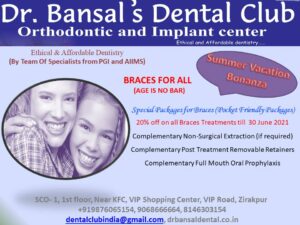Full Mouth Rehabilitation
“You are not fully dressed until you wear a Smile”
Full mouth reconstruction, also known as full mouth rehabilitation or full mouth restoration is a comprehensive form of dental treatment which could combine all dental specialties viz. Endodontics, Prosthodotics, Orthodontics, Implantology etc. to reconstruct and restore all the damaged teeth in both upper and lower jaws.
Based upon your concern and budget, a comprehensive treatment plan will be created that will address your concerns using the latest technologies available in advanced specialized dentistry that will enable you to look and feel great and allow you to eat comfortably.
Indications of Occlusal Rehabilitation
- Restore impaired Occlusal function
- Preserve longevity of remaining teeth
- Maintain healthy Periodontium
- Improve objectionable Esthetics
- Eliminate pain and discomfort of teeth and surrounding structures.
Contraindications of Full Mouth Rehabilitation
- Malfunctioning mouths that do not need extensive dentistry and have no joint symptoms should be best left alone.
- Prescribing full mouth rehabilitation should not be taken as a preventive measure unless there is a definite evidence of tissue breakdown.
In short, it can be concluded that: No pathology- No treatment.
Etiology of Extremely Worn Dentition
Occlusal wear is most often attributed to attrition. Attrition is defined as ‘the wearing away of one tooth surface by another tooth surface’.
The causes for worn dentition are –
- Congenital abnormalities
- Amelogenesis imperfecta
- Dentinogenesis imperfecta
- Parafunctional Occlusal Habits like Abrasion, Erosion etc
- Loss of posterior support — Posterior collapse that results from missing, tipped, rotated, broken down teeth, malposition and occlussal interference exerts undue force on anterior teeth resulting in teeth mobility and excessive wear of clinical crown.
Diagnosis & Treatment Plan of Full Mouth Rehabilitation
Diagnosis of Full Mouth Rehabilitation
The following aids should be used – –
- Medical history –
- Dental history –
- Behaviour evaluation –
- Radiographs – Complete mouth periapical radiographs and orthopentamograph
- Photographs – colour of teeth and gingiva is recorded and photographs are necessary to recall to patient’s mind the state of his mouth prior to restorative dentistry. –
- Clinical examination
- Diagnostic wax-up –
- Computer imaging – It is helpful to demonstrate the various treatment options. Computer aided image manipulation can be used to create the future appearance.
Diagnostic wax-up for Full Mouth Rehabilitation
Before diagnostic wax-up, the occlusal discrepancies in centric and eccentric occlusion should be eliminated.
- Diagnostic preparation of gypsum stone teeth that will require prospective crowns is carried out. This will reveal any resistance or retention form problems caused by short axial walls.
- Then planning of subgingival margins or surgical crown lengthening required can be done.
- Then wax is used to appropriately shape all crowns and final prosthesis is planned. •
- This diagnostic wax-up can be used to prepare an elastomeric putty mould and used for temporization or sectioned through long axis of tooth to act as reduction guide intra-orally.
Treatment plan for Full Mouth Rehabilitation
Comprehensive treatment plan must be established prior to start of the treatment.
Communication and patient education are essential in order to match the dentist’s and patient’s definition of success.
Treatment plan is divided into-
1) Pre- prosthetic phase
2) Prosthetic phase
3) Maintenance phase
1) Pre- prosthetic phase – To develop proficiency in diagnosing the need of occlusal rehabilitation, Periodontist, Orthodontist, Endodontist, Oral Surgeon and Prosthodontist must all be integrated in establishing an environment conducive to oral health.
2) Prosthetic phase – Prosthetic full mouth rehabilitation is divided into –
• Immediate treatment • Definitive treatment
Immediate treatment – In some cases like amelogenesis imperfecta in a child, postponing treatment until adulthood may cause adverse psychological effect and impair correct relationship between maxillary and mandibular teeth.
- Preformed nickel-chromium crowns are placed on first permanent molars and second deciduous molars to stabilize occlusion and halt attrition. – Vertical dimension is not altered.
- As anterior teeth and premolars erupt, polycarbonate resin crowns are given.
- Second molar is fitted with nickel crown to preserve vitality.
- After all permanent teeth are erupted, these restorations serve as transitional treatment until adulthood.
Definitive treatment – Once all teeth have erupted and adulthood is reached, the size of pulp horns decreases compared to newly erupted teeth. A definitive treatment can then be planned.
” Let your smile change the world but don’t let the world change your smile “
For more information Contact Us or you can Call us directly.

